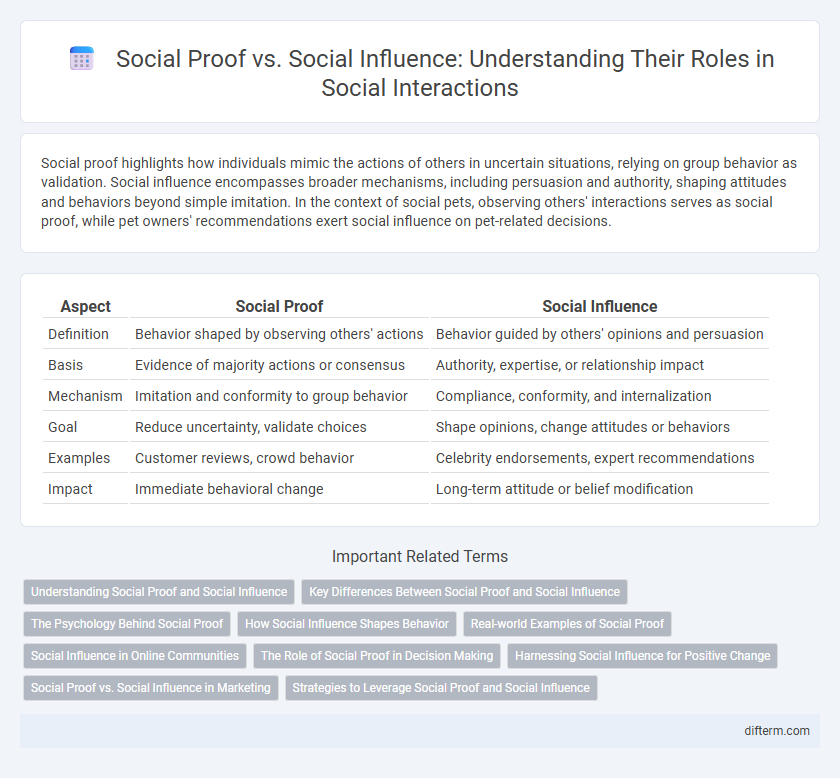Social proof highlights how individuals mimic the actions of others in uncertain situations, relying on group behavior as validation. Social influence encompasses broader mechanisms, including persuasion and authority, shaping attitudes and behaviors beyond simple imitation. In the context of social pets, observing others' interactions serves as social proof, while pet owners' recommendations exert social influence on pet-related decisions.
Table of Comparison
| Aspect | Social Proof | Social Influence |
|---|---|---|
| Definition | Behavior shaped by observing others' actions | Behavior guided by others' opinions and persuasion |
| Basis | Evidence of majority actions or consensus | Authority, expertise, or relationship impact |
| Mechanism | Imitation and conformity to group behavior | Compliance, conformity, and internalization |
| Goal | Reduce uncertainty, validate choices | Shape opinions, change attitudes or behaviors |
| Examples | Customer reviews, crowd behavior | Celebrity endorsements, expert recommendations |
| Impact | Immediate behavioral change | Long-term attitude or belief modification |
Understanding Social Proof and Social Influence
Social proof is the psychological phenomenon where individuals mimic the actions of others in an attempt to reflect correct behavior in a given situation. Social influence involves the ways in which individuals change their thoughts, feelings, or behaviors in response to real or imagined social pressure. Understanding the distinction between social proof and social influence is crucial for marketers and social scientists aiming to leverage peer behavior and societal norms effectively.
Key Differences Between Social Proof and Social Influence
Social proof refers to individuals adopting behaviors or decisions based on the observed actions of others in similar situations, emphasizing conformity through collective validation. Social influence encompasses a broader range of effects, including persuasion, compliance, and obedience, driven by various social factors such as authority, relationships, or social norms. Key differences lie in social proof's reliance on the behavior of peers as evidence for correctness, whereas social influence involves direct or indirect pressure from others to shape attitudes or actions.
The Psychology Behind Social Proof
The psychology behind social proof reveals that individuals often rely on the behavior and opinions of others to make decisions, especially in uncertain situations. This cognitive shortcut stems from the innate human desire for social acceptance and the assumption that the majority's actions reflect correct behavior. Social proof operates on principles of conformity and trust, shaping choices in marketing, social media, and everyday interactions.
How Social Influence Shapes Behavior
Social influence shapes behavior by altering individuals' attitudes, beliefs, and actions through group pressure, norms, and expectations. Unlike social proof, which relies on observing others' behavior to guide decisions, social influence actively involves persuasive communication and socialization processes. Psychological mechanisms such as conformity, compliance, and obedience drive the changes in behavior within social contexts.
Real-world Examples of Social Proof
Retail stores often use product reviews and ratings as social proof to influence purchasing decisions, demonstrating how customer feedback drives new buyers. Online platforms like Amazon display bestseller lists and user testimonials, leveraging social proof to boost product credibility and sales. Social media trends, such as viral challenges, provide real-world examples where social proof motivates widespread participation through peer validation.
Social Influence in Online Communities
Social influence in online communities drives user behavior through peer interactions, shared norms, and perceived authority, significantly impacting decision-making and engagement. Members are more likely to adopt trends, opinions, or products when influenced by trusted community figures or majority consensus. This dynamic fosters trust, credibility, and a sense of belonging, enhancing overall community cohesion and participation.
The Role of Social Proof in Decision Making
Social proof plays a critical role in decision making by serving as a psychological shortcut that helps individuals evaluate options based on the behaviors and endorsements of others. It leverages collective validation, often seen in customer reviews, testimonials, and popularity metrics, to reduce uncertainty and increase confidence in choices. Unlike social influence, which involves direct persuasion or authority, social proof operates through observation and perceived consensus, making it a powerful driver in consumer behavior and social conformity.
Harnessing Social Influence for Positive Change
Harnessing social influence involves leveraging group dynamics and peer behavior to inspire positive change by encouraging desirable actions and attitudes. Social proof operates as a psychological mechanism where individuals look to others' behaviors to determine their own, emphasizing the impact of visible, collective endorsement. Effective strategies integrate social influence with targeted messaging to foster community engagement and drive sustainable social improvements.
Social Proof vs. Social Influence in Marketing
Social proof in marketing leverages consumer behavior and testimonials to validate product trustworthiness, enhancing purchase decisions through perceived popularity. Social influence involves shaping consumer preferences and attitudes by authoritative endorsements, opinion leaders, or peer pressure, driving brand loyalty and engagement. Combining social proof and social influence strategies amplifies marketing effectiveness by addressing both trust and persuasive dynamics in consumer psychology.
Strategies to Leverage Social Proof and Social Influence
Leveraging social proof involves showcasing authentic testimonials, user reviews, and influencer endorsements to build credibility and trust among potential customers. Social influence strategies focus on engaging influential figures and fostering community interactions that encourage peer recommendations and shared behaviors. Combining both approaches enhances brand visibility and drives higher conversion rates by tapping into people's natural tendency to follow the actions of others.
social proof vs social influence Infographic

 difterm.com
difterm.com